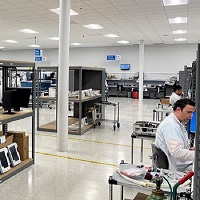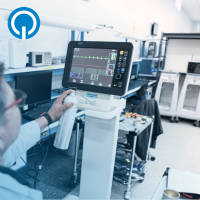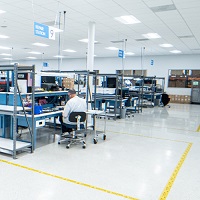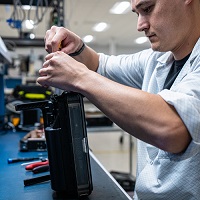
Unlocking Peak Performance with Key MedTech Service Metrics
What OEMs should be tracking—and what they often miss
While standard Service-Level Agreements (SLAs) and commonly watched metrics like response time or overall system uptime are important, they don’t paint the full picture. This is especially critical as medical device technology becomes more sophisticated, and healthcare models increasingly shift towards value-driven outcomes. These conventional KPIs can easily miss what truly drives performance: how genuinely effective, efficient, and reliable your service operations actually are.
That's why, at Quest International, our focus is on digging deeper to find the data that truly tells the story of service performance. This post explores the service metrics that offer genuine insight into your operations, highlighting those often undervalued or even overused. Understanding and leveraging these distinct metrics is often where we see the biggest difference between companies merely reacting to daily fires and those proactively building intelligent, scalable, and future-proof service models.
Are we fixing it right—and fast enough?
First-Time Fix Rate (FTFR) is one of the clearest indicators of service performance. It shows how often technicians resolve issues on the first visit. In imaging, surgical, and lab environments, this is the difference between routine service and delayed procedures, directly impacting patient throughput and clinical decision-making. If FTFR drops, customer trust drops with it. Also, FTFR is linked to repeat visit costs, and improvements on FTFR also reflect enhanced engineer productivity, boosting profitability.
Mean Time to Repair (MTTR) tracks how long it takes to complete a service task after it begins. Shorter MTTR keeps workflows moving and limits the cost of device downtime.
Mean Time Between Failures (MTBF) looks beyond repair speed and into reliability. If the same unit comes back again and again, you’re not fixing the root cause. MTBF trends can point to underlying product issues, gaps in service consistency or even the need for proactive component replacement strategies.
Turnaround Time (TAT) is critical for depot repair programs. This measures the time from receiving a unit to returning it. OEMs with long TATs often compensate with extra inventory or loaners, but that’s a short-term fix and a costly one, impacting overall profitability. Reliable TAT keeps field teams confident and customers calm.
What are we missing in parts and inventory?
One of the biggest hidden cost centers in service is parts overuse.
Parts Per Call (PPC), or parts usage rate, can reveal a lot about technician behavior. When this number is unusually high, it often means techs are swapping parts to troubleshoot instead of following proper diagnostics, leading to increased parts costs and potentially unnecessary RMAs (Return Material Authorizations).
No Fault Found Rate (NFFR) is another overlooked metric. These are the devices that come in for service but have no verifiable issues. They take up time, drain resources, and frustrate both field teams and customers. High NFFR can point to problems with device design, unclear documentation, lack of user training, or even issues with the field diagnostic tools/processes.
Spare Parts Fill Rate—how often your parts are available immediately—is rising in importance. With supply chain constraints still affecting global service models, OEMs with strong fill rates are outperforming on both FTFR and SLA compliance and reducing costly delays or repeat visits due to part unavailability.
Are we actually improving the customer experience?
Satisfaction metrics aren’t just fluff. They’re critical signals of whether your service model is sustainable.
Customer Satisfaction (CSAT) is still one of the most reliable indicators of how well your teams are performing. But timing matters. The best OEMs survey customers within 24–48 hours of the service event to get real feedback while it’s fresh.
Net Promoter Score (NPS) is widely used but often misunderstood. It can be helpful for understanding long-term brand perception—but it doesn’t always reflect individual service experiences. Therefore, it should be used in conjunction with transactional CSAT, not as a replacement. Some OEMs over index on NPS without tying it back to actual performance or resolution data.
Complaint Resolution Time matters more than ever in today’s regulatory environment. Delays here can lead to CAPAs, audit flags, or worse. This metric is critical not just for compliance, but for building long-term customer trust.
Regulatory Audit Readiness isn’t tracked as often as it should be. This refers to whether your service documentation is fully traceable, up to date, and ready for inspection. In an FDA or ISO audit, service logs are often one of the first things reviewed. Being prepared protects your team and your brand.
How are our technicians really performing?
Field service is still a people business. Metrics that track your team’s performance help you build capacity without overextending.
Technician Utilization Rate helps leaders understand how much of a tech’s time is spent on productive, value-adding work. If utilization is low, you may be overstaffed—or underusing your best people.
Repeat Visit Rate often flies under the radar. A high repeat visit rate signals inefficiencies. This could stem from a training issue, unclear work instructions, or even device complexity.
Training and Certification Completion is one of the most straightforward compliance metrics—but often gets neglected. Especially during periods of growth or turnover, it’s important to ensure that every tech on the floor is trained, certified, and current not just for compliance, but to ensure consistent, high-quality service delivery and first-time fix rates.
Final Thought: Choose metrics that reflect real performance
Not every OEM needs to track every metric. But every service organization needs to be intentional about which metrics they prioritize—and why.
At Quest, we work with medical device OEMs to go beyond SLAs. We help teams identify operational blind spots, improve workforce readiness, and build service systems that scale with quality and control. Whether you need better depot turnaround or scalable field coverage, our goal is to operate like a true extension of your internal team.
Let’s help you measure what really matters—so your customers feel the difference.
Ready to identify the metrics that will drive real change for your MedTech service operations? Contact us today for a complimentary consultation.
MAR-276 REV 1.0












